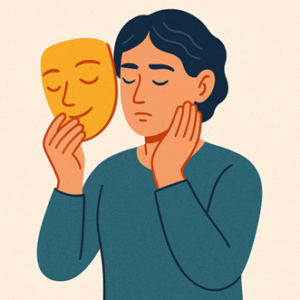
The Hidden Cost of “Fitting In” Why Conformity Hurts Everyone
The Thought Experiment
Imagine walking into a meeting wearing a mask — not a festive one, but a version of yourself you’ve crafted to make everyone else comfortable. You’ve practiced the right smile, muted your gestures, rehearsed small talk. The moment ends, and you feel wrung out.
That’s what many neurodivergent people experience daily. Not for a few hours, but across classrooms, workplaces, and social spaces. This act — called masking — isn’t a choice made out of vanity or shyness. It’s survival.
The National Autistic Society (NAS) defines masking as a way “to hide or manage autistic characteristics to fit in with others.” For some, that means suppressing stimming; for others, mimicking small talk patterns. On the surface, it helps people blend in. Underneath, it slowly erodes wellbeing.
“When the room only accepts one rhythm, people spend their talent on blending, not contributing.”
Why we Learn to mask

Masking grows from social rules — those subtle cues that tell us which behaviours are “acceptable.” The NAS points out that these expectations are rarely designed with neurodivergent people in mind. They come from a majority experience: eye contact, quick replies, tolerating background noise, emotional regulation that matches certain norms.
So, if you’re autistic, have ADHD, dyslexia, dyspraxia, Tourette’s, or any other neurotype outside that median, you learn early on to “read the room” and adapt. According to the ADHD Foundation, this starts in school. Children internalise the idea that success means sitting still, learning one way, performing one kind of attention. Those who can’t often absorb shame before they even learn self-acceptance. When expectations stay narrow, many pupils internalise the idea that success requires hiding their authentic style.
The point isn’t that accommodation is exceptional treatment. It’s the opposite. Human brains are naturally variable. Organisations like the British Dyslexia Association (BDA) frame neurodiversity as part of ordinary human difference, to be recognised and respected in the same way we respect other forms of diversity.
But here’s the trick: everyone masks to some degree — smoothing edges to get through social life. The difference is intensity and cost. For neurodivergent people, masking isn’t occasional. It’s structural. It’s the tax paid for access.
The personal toll of “fitting in”
The National Autistic Society has gathered countless testimonies showing that long-term masking leads to exhaustion, burnout, depression, and, in some cases, suicidal ideation. Research published in Autism in Adulthood (Hull et al., 2021) confirms this: high levels of masking correlate with anxiety and delayed diagnosis.
People often describe feeling “split” — performing one version of themselves publicly and another privately. The Dyspraxia Foundation adds that adults who grow up masking struggle later in professional life, often being misunderstood as disorganised or inattentive, when the reality is ongoing cognitive overload.
This isn’t rare. The British Dyslexia Association highlights that one in ten people in the UK are dyslexic, and many hide their struggles for fear of judgment. The emotional cost is chronic vigilance: “Will I be found out?” “Will they think I’m lazy?” “Will this one mistake undo all the work I did to appear capable?”
When “Normal” Becomes the Problem
Here’s the uncomfortable truth: conformity often hides under the word professionalism. Offices prize “good communication,” “team fit,” “attention to detail,” or “energy” — all good things in moderation. But beneath them sits a narrow model of how people “should” behave.
The ADHD UK charity points out that when we define productivity by constant focus and consistency, we exclude those whose brilliance comes in bursts — high creativity, quick problem-solving, rapid context-shifting. Similarly, Genius Within, a neurodivergent-led organisation, reminds employers that strengths like pattern recognition, hyperfocus, and innovative thinking often appear alongside the traits that neurotypicals label as “difficult.”
This isn’t about special treatment. It’s about honest infrastructure design. The Made by Dyslexia campaign puts it bluntly: dyslexic minds “think differently, not incorrectly.” The challenge is that our systems reward sameness.
And sameness is the enemy of innovation.
Communities Shrink When Minds Hide
When people must mask to survive, communities lose something subtle but vital — diversity of thought. The ADHD Foundation often describes neurodiversity as “the DNA of innovation.” And they’re right. From dyslexic creativity to autistic system-thinking to ADHD dynamism, difference fuels progress.
So, when we force individuals into uniform behaviour, we flatten our collective imagination. The social scientist Thomas Armstrong called neurodiversity “the natural variability of the human brain.” That variability is what lets one person design a bridge, another compose music, another see emotional patterns no one else notices.
The tragedy? Many of those people never get to contribute that gift because they’re too busy pretending to be “normal.”
The Human Cost of Belonging
Let’s get personal for a moment. Imagine a child in a classroom — let’s call him Sam. Sam’s brain runs on pattern-seeking. He hyper-focuses on how things connect, but teachers say he’s “daydreaming.” To fit in, he stops asking questions, keeps quiet, blends. By secondary school, he’s internalised that blending is safety.
Years later, Sam’s in a meeting where people praise “out-of-the-box thinking.” Irony? He’s learned to stay inside the box so well he can’t find the lid anymore.
That’s the social wound of conformity — and it cuts deep. According to Ambitious about Autism, children who are encouraged to express their needs and differences early on develop stronger self-advocacy and life outcomes. But without that permission, masking becomes muscle memory.
The Tourette’s Action charity echoes this in their awareness campaigns: acceptance and understanding from others dramatically reduce distress and symptom severity. In other words, society’s attitude literally changes people’s wellbeing.
What Happens When We Stop Demanding Masks
Now, here’s the hopeful part: communities can change. The Scope disability equality charity calls for “a society where disabled people have the same opportunities as everyone else.” That’s not about charity — it’s about equality of design.
Practical examples:
- Workplaces: flexible scheduling, quiet zones, alternative meeting formats (written input instead of verbal).
- Schools: sensory-friendly classrooms, multi-modal learning, co-created behaviour policies.
- Community groups: slower pacing, clearer communication, open consent for social participation.
These aren’t luxuries. They’re the infrastructure of inclusion. When we do this, something powerful happens: people start unmasking. Slowly, tentatively, then proudly. And as the National Autistic Society notes, “unmasking in safe spaces leads to improved mental health, authentic connection, and resilience.”
The ripple spreads outward. A culture that allows difference doesn’t just help neurodivergent people; it models empathy for everyone.
The Economics of Inclusion
If compassion alone doesn’t convince policymakers or leaders, the data should. A 2022 report by Genius Within and Birkbeck University found that neuro-inclusive adjustments significantly reduced turnover, improved engagement, and increased productivity. Employees who received personalised support were three times more likely to remain in their jobs long-term.
How to Shift a Culture
You don’t need a grand strategy. You need curiosity.
Here are a few reflective steps — use them as discussion prompts or journaling cues:
- Audit the unspoken rules.
Who benefits from them? Who struggles quietly? - Challenge speed culture.
Fast isn’t always effective. Space allows more minds to contribute. - Redefine “”
Does it mean polished performance, or genuine connection? - Model imperfection.
Leaders who admit their own neuro-quirks normalise difference. - Ask, don’t assume.
Support starts with listening. The ADHD Foundation trains employers in conversation-based adjustments rather than blanket policies.
When difference becomes visible and safe, conformity loses its power.
From Fitting In to Belonging
“Belonging” isn’t earned through masking — it’s created through acceptance. The British Dyslexia Association and Scope both argue that society must shift from awareness to allyship. That means designing systems that don’t merely include neurodivergent people but are built with them.
Because belonging is the opposite of performance. It’s presence.
And that presence benefits everyone — the colleague who can finally think freely, the student who stops second-guessing, the parent who no longer hides their sensory overwhelm, the leader who learns to pause instead of push.
Closing Reflection
Let’s revisit the opening thought: the meeting, the mask, the drain.
Now imagine the same room — no mask, no code-switching, no fear. Just different brains thinking out loud in their natural rhythms. There’s quiet and buzz, precision and chaos, detail and big-picture. It’s not tidy, but it’s alive.
That’s what a truly inclusive community feels like — real, messy, human.
So, if we want innovation, resilience, and compassion, we start by letting people stop pretending. The world doesn’t need more polished performers. It needs more honest minds, working side by side, as themselves.
References & Further Reading
- ADHD Foundation — About Neurodiversity
- ADHD UK — Right to Choose
- Ambitious about Autism — Parent Toolkit
- British Dyslexia Association — Dyslexia and Neurodiversity
- Dyspraxia Foundation — Understanding Dyspraxia
- Genius Within — Workplace Inclusion Research
- Hull, L. et al. (2021). Autism in Adulthood, 3(2), 111–122.
- Made by Dyslexia — Think Dyslexia Campaign
- National Autistic Society — Masking and Autism
- Scope — Equality and Disability
- Tourette’s Action — Living with Tourette Syndrome

